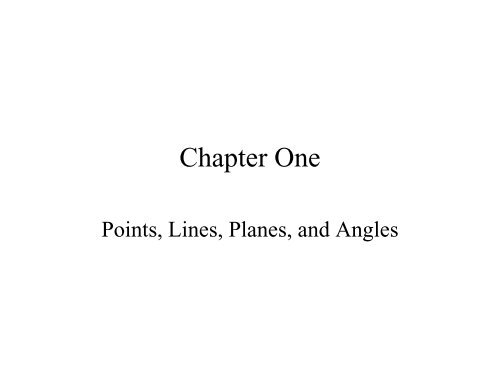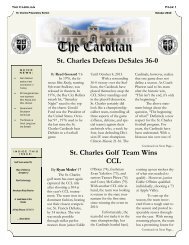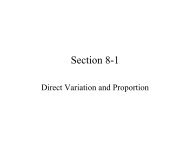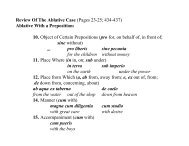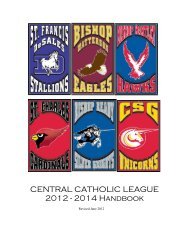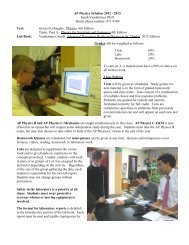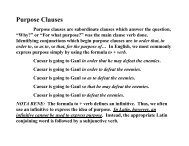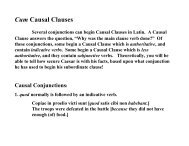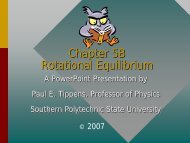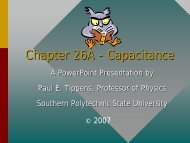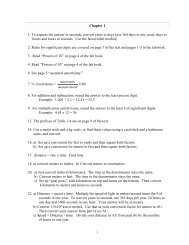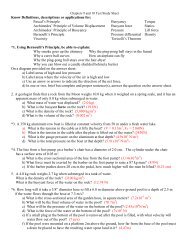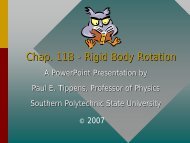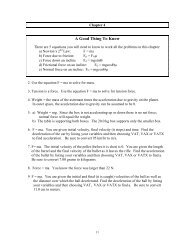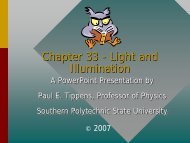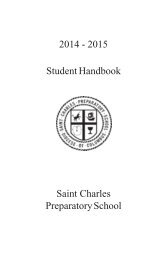Create successful ePaper yourself
Turn your PDF publications into a flip-book with our unique Google optimized e-Paper software.
<strong>Ch</strong>apter One<br />
Points, Lines, Planes, and Angles
Objectives<br />
A. Use the terms defined in the<br />
chapter correctly.<br />
B. Properly use and interpret the<br />
symbols for the terms and<br />
concepts in this chapter.<br />
C. Appropriately apply the postulates<br />
and theorems in this chapter.<br />
D. Correctly interpret the information contained in two and three<br />
dimensional diagrams.<br />
E. Correctly interpret and represent the information given in<br />
problems with either a two or three dimensional diagram.
Section 1-1<br />
A Game and Some <strong>Geometry</strong>
Objectives<br />
A. Use the terms equidistant<br />
correctly.<br />
B. Understand the nature of math and<br />
science.<br />
C. Distinguish between valid and<br />
invalid assumptions in geometry.
Nature of Math & Science<br />
• Defines reality.<br />
• Describes our sensory<br />
experiences.<br />
• Impacts every life.<br />
• Based on unproven<br />
assumptions.<br />
• Does not conflict with religion.
Always assume that:<br />
GO<br />
• Lines are straight.<br />
• Angles exist.<br />
• Points on a line are<br />
collinear.<br />
• There are unlabeled points<br />
in the diagram.<br />
• Points have the relative<br />
positions drawn.
Never assume that:<br />
STOP<br />
• Angles measure 90.<br />
• Angles are equal.<br />
• Segments are equal.<br />
• Angles and segments are<br />
as large or as small as they<br />
appear.<br />
• An answer is correct<br />
because of the way it<br />
looks.
EQUIDISTANT<br />
• Equidistant has the prefix ‘equi’, meaning equal, and a<br />
suffix of distant. Therefore, two locations that are<br />
equidistant from a third location are the same distance<br />
from the third location.<br />
• <strong>Ch</strong>oose two locations in this classroom that you believe are<br />
equidistant from your desk.<br />
• <strong>Ch</strong>eck the distance to those locations.<br />
• Are the distances approximately equal<br />
• Are the distances exactly equal<br />
• Why or why not
Sample Problems Section 1-1<br />
• Look at problem 5 on page 4 of your book. Which<br />
distance is appears to be greater:<br />
– The distance from R to S, or<br />
– The distance from T to U.<br />
– <strong>Ch</strong>eck your answer!<br />
• Look at problem 7 on page 4 of your book. What is the<br />
relationship of the inner square to the outer square<br />
– <strong>Ch</strong>eck using a square piece of paper.
Section 1-2<br />
Points, Lines and Planes<br />
Homework Pages 7-9:<br />
1-32
Objectives<br />
A. Understand the meaning of, and<br />
the reasons for, undefined terms.<br />
B. Use the undefined terms point,<br />
line and plane correctly.<br />
C. Use the undefined terms to define<br />
the terms space, collinear points,<br />
and coplanar points.<br />
D. Use the correct naming conventions for points, lines, and planes.<br />
E. Create proper graphic representations of points, lines, planes,<br />
and intersections, including the use of dotted lines.
UNDEFINED TERMS<br />
• Undefined terms are considered intuitive ideas.<br />
– You have a grasp of the concept represented by the<br />
term.<br />
– These terms are ‘accepted on faith’ and are used to<br />
define other terms.<br />
• point: any location having no dimension.<br />
– A point is labeled with a single capital letter.<br />
– Graphically, we represent a point as a dot on a page.
GRAPHICAL REPRESENTATIONS<br />
We use graphical representations of points, line, and planes to<br />
convey the meaning of the object or figure.<br />
BE CAREFUL!<br />
• Remember that these are REPRESENTATIONS and are<br />
not exact.<br />
GRAPHICAL REPRESENTATION OF A POINT<br />
• Represented as a dot.<br />
• Labeled with a single capital letter.<br />
Point A<br />
A
UNDEFINED TERMS - Line<br />
• line: is a set of points extending infinitely in two<br />
directions.<br />
– Has one dimension => length.<br />
• Since a line extends infinitely in two directions, the<br />
length of any line is infinite.<br />
– Has NO width.<br />
• We will see why we say this later.<br />
– A line is labeled either:<br />
• with a single lower case letter (l), or<br />
• with the labels of two points on the line with a line<br />
symbol () above them.<br />
– Remember to assume that all lines are straight!<br />
– Graphically, we represent it as a straight line with<br />
arrows on both ends.
GRAPHICAL REPRESENTATION - Lines<br />
Lines may be labeled with a single lower-case letter.<br />
k<br />
<br />
Lines may be labeled using two points on the line: AB<br />
A<br />
B<br />
8
UNDEFINED TERMS - Plane<br />
• Plane: is a set of points that make up a flat surface. The<br />
surface extends infinitely in two directions.<br />
– Has two dimension => length and width.<br />
• Since a plane extends infinitely in two directions,<br />
the length and width of any plane is infinite.<br />
– Has NO thickness.<br />
• We will see why we say this later.<br />
– A plane is labeled either with a single capital letter not<br />
representing the label of a point or with the labels of<br />
three non-collinear points on the plane.<br />
– Graphically, we represent a plane as having four edges.
GRAPHICAL REPRESENTATION - Planes<br />
Planes may be labeled with a single capital letter<br />
not associated with a point in the plane: plane M<br />
M<br />
Planes may be labeled using three<br />
non-collinear points in the plane: plane ABC<br />
A<br />
C<br />
B<br />
9
GRAPHICAL REPRESENTATIONS –<br />
3-dimmensional objects<br />
Dotted lines Used in three dimensional figures and<br />
indicate the parts of the figure which would be hidden<br />
from view if the figure were solid.<br />
R<br />
S<br />
h<br />
B<br />
D<br />
A<br />
<br />
C
TERMS BASED ON UNDEFINED TERMS<br />
Now that we have some basic terms, we can use these to build<br />
other definitions.<br />
• collinear points: points all on one line<br />
• coplanar points: points all on one plane<br />
• space: the set of all points<br />
• intersection: the set of points common to two or more<br />
figures<br />
– You will see that the actual intersection of two figures<br />
could be a point, a line, a plane, or other figures.
Sample Problems Section 1-2<br />
Classify each statement as true or false.<br />
<br />
1. AB is in plane R.<br />
3. Planes R and S contain D.<br />
5. h is in plane S.<br />
7. Plane R intersects plane S in<br />
AB<br />
<br />
9. A, B and C are collinear.<br />
R<br />
A<br />
<br />
C<br />
h<br />
D<br />
S<br />
B
Sample Problems Section 1-2<br />
11. Make a sketch showing four coplanar points such that<br />
three, but not four, of them are collinear.<br />
13. Name five planes that contain sides of the pyramid.<br />
15. Name three lines that intersect at point R.<br />
17. Name three planes that intersect at point S.<br />
V<br />
W<br />
T<br />
R<br />
S
Sample Problems Section 1-2<br />
19. Draw a rectangular solid box.<br />
21. Name two planes that intersect in FG <br />
23. Name three planes that intersect at point B.<br />
25.a. Are points R, S, G, and F coplanar<br />
b. Are points R, S, G, and C coplanar<br />
S<br />
R<br />
H<br />
G<br />
E<br />
F<br />
D<br />
C<br />
A<br />
B
Sample Problems Section 1-2<br />
27. Can two horizontal planes intersect<br />
Sketch and label the figure described. Use dashed lines<br />
for hidden parts.<br />
29. Vertical line l intersects a horizontal plane M at point O.<br />
31. Horizontal plane Q and vertical plane N intersect.<br />
33. Point P is not in plane N. Three lines through point P<br />
intersect plane N in points A, B, and C.
Section 1-3<br />
Segments, Rays and Distance<br />
Homework Pages 15-16:<br />
1-46
Objectives<br />
A. Understand the concept of<br />
congruence.<br />
B. Use the term congruence<br />
correctly.<br />
C. Use the terms segment, ray,<br />
opposite ray, and segment length<br />
correctly.<br />
D. Use the terms midpoint and bisector correctly.<br />
E. Understand the meaning and use of postulates or axioms.<br />
F. Apply the Ruler and Segment Addition Postulates correctly.
CONGRUENCE<br />
congruent: to be the same size and shape. The symbol for<br />
congruence is @<br />
• congruent segments: segments of equal length<br />
• Note that congruence requires same size AND SHAPE.<br />
– Example: Two circles have the same shape. Two<br />
circles with identical radii lengths are congruent<br />
• Same shape Circle<br />
• Same size equal radii
LINEAR ‘PARTS’<br />
• Remember a line is an undefined term that is understood<br />
to mean the set of all points extending infinitely in two<br />
directions.<br />
• Points are collinear if they are all part of the same line.<br />
• A line segment, or segment, is a set of points consisting<br />
of two points (endpoints) on a line and all the points in<br />
between.<br />
–A segment is labeled with a bar over its endpoints.<br />
Line GH<br />
G<br />
C<br />
D<br />
H<br />
Line Segment CD with endpoints C and D<br />
Collinear points G, C, D, and H
LINEAR ‘PARTS’ - Rays<br />
•A ray is a set of points on a line beginning with an<br />
endpoint and traveling infinitely in one direction.<br />
–A ray is labeled with its endpoint first and another<br />
point on the ray with an arrow above the letters.<br />
(ORDER)<br />
•Opposite rays are two coplanar rays with the same<br />
endpoint traveling in opposite directions<br />
Ray MN<br />
M<br />
T<br />
N<br />
Ray TM<br />
Opposite rays TM and TN
LINEAR CHARACTERISTICS - Coordinate<br />
• coordinate: the real number assigned to a point on a<br />
number line.<br />
-7 12<br />
F<br />
G<br />
Line FG<br />
-7 is the coordinate of point F.<br />
12 is the coordinate of point G.
LINEAR CHARACTERISTICS - Length<br />
• length: the distance between the endpoints of a segment;<br />
the absolute value of the difference of the coordinates of<br />
the endpoints<br />
– The length of a line segment is represented by the two<br />
endpoints of the segment WITHOUT a bar over them.<br />
-4 12<br />
S<br />
Segment ST<br />
-4 is coordinate of point S. 12 is coordinate of point T.<br />
| -4 – 12 | = 16. Therefore ST = 16, or the length of ST is 16.<br />
T
LINEAR CHARACTERISTICS –<br />
Midpoints and segment bisectors<br />
• midpoint of a segment: a point dividing a segment into<br />
two congruent segments (size and shape are the same)<br />
• bisector of a segment: a line, segment, ray or plane that<br />
intersects a segment at its midpoint<br />
4 7<br />
10<br />
t<br />
K<br />
M<br />
L<br />
KL with 4 as coordinate of point K and 10 as coordinate of point L.<br />
Point M is midpoint of KL because KM = ML = 3.<br />
Line t is the bisector of segment KL because it intersects KL at<br />
its midpoint.
Postulates & Theorems<br />
• Tell you how to solve every problem in this book.<br />
• Rules broken into two parts:<br />
– Hypothesis:<br />
• A statement that tells you when to use the rule.<br />
• A statement that tells you what must be true in order<br />
to use/apply this rule.<br />
• It is usually a description of a picture.<br />
– Conclusion:<br />
• A statement of how to use the rule.<br />
• A statement that tells you what is true IF the<br />
hypothesis is true FIRST.<br />
• It is usually an equation or a description of what to<br />
add to the picture
POSTULATES<br />
• postulate (axiom): statements which are accepted as true<br />
without proof.<br />
• Postulates are similar to undefined terms as we accept both<br />
on faith, without proof.
Postulate 1 (Ruler Postulate)<br />
• The points on a number line can be paired with the real<br />
numbers in such a way so that any two points can have<br />
coordinates 0 and 1<br />
A B C D E F G H I<br />
-4<br />
-3<br />
-2<br />
-1<br />
0 1 2 3 4<br />
• Once a coordinate system has been chosen in this way, the<br />
distance between any two points equals the absolute value<br />
of the difference of their coordinates<br />
CH = -2 - 3= -5
Postulate 2 (Segment Addition Postulate)<br />
If B is between A & C, then AB + BC = AC.<br />
A<br />
B<br />
C<br />
-4 5 9<br />
AB = -4 - 5=-9= 9<br />
BC = 5 - 9= -4= 4<br />
AC = -4 - 9 -13 = 13<br />
AB + BC = 9 + 4 = 13 = AC
Congruent Segments in Diagrams<br />
Congruent segments are marked with slashes. One slash for the<br />
first pair of congruent segments, two slashes for the second pair, etc.<br />
7
Sample Problems Section 1-3<br />
The numbers given are the coordinates of the two points<br />
on a number line. State the distance between the points.<br />
1. - 6 and 9<br />
3. - 1.2 and - 5.7
Sample Problems Section 1-3<br />
<br />
In the diagram, HL and KT intersect at the midpoint of<br />
Classify each statement as true or false.<br />
HL<br />
5.<br />
LM @ MH<br />
H<br />
7.<br />
9.<br />
MT bisects LH<br />
<br />
<br />
MT and TM are opposite<br />
rays<br />
T<br />
11.<br />
13.<br />
LH <br />
<br />
is thesame as HL<br />
<br />
KT is the same as KM<br />
M<br />
15. HM + ML = HL<br />
K <br />
17. T is between H and M.<br />
L
Name each of the following.<br />
Sample Problems Section 1-3<br />
19. The point on whose distance from D is 2.<br />
21. Two points whose distance from E is 2.<br />
23. The midpoint of<br />
DA BF<br />
25. The coordinate of the midpoint of<br />
AE<br />
A B C D E F G<br />
- 3 - 2 - 1 0 1 2 3
Sample Problems Section 1-3<br />
Draw CD and RS so that the conditions are satisfied.<br />
27. CD and RS intersect, but neither segment bisects the<br />
other.<br />
29. CD bisects RS, but RS does not bisect CD
Sample Problems Section 1-3<br />
31. In the diagram, PR @ RT S is the midpoint of<br />
QR = 4, and ST = 5. Complete.<br />
31.a. RS =<br />
31.b. RT =<br />
31.c. PR =<br />
31.d. PQ =<br />
RT<br />
P Q R S T
Sample Problems Section 1-3<br />
E is the midpoint of DF . Find the value of x.<br />
33. DE = 5x + 3, EF = 33<br />
35. DE = 3x, EF = x + 6<br />
E<br />
G<br />
Find the value of y.<br />
37. GE = y, EH = y - 1, GH = 11<br />
D<br />
Find the value of z. Then find GE and EH and state<br />
whether E is the midpoint of GH<br />
39. GE = z + 2, GH = 20, EH = 2z - 6<br />
F<br />
H
Sample Problems Section 1-3<br />
Name the graph of the given equation or inequality.<br />
41. - 2 x 2<br />
43. x 4<br />
45. x = 0<br />
G H M N T Y Z<br />
- 4 - 2 0 2 4 6 8
Section 1-4<br />
Angles<br />
Homework Pages 21-22:<br />
1-34<br />
Excluding 22
Objectives<br />
A. Understand how angles are<br />
constructed, labeled, represented<br />
graphically, and measured.<br />
B. Use the terms angle, sides, and<br />
vertex correctly.<br />
C. Understand congruent and<br />
adjacent angles.<br />
D. Identify and define acute, right, obtuse, and straight angles.<br />
E. Use the term bisector of an angle correctly.<br />
F. Apply the Protractor and Angle Addition Postulates correctly.
THE ‘MAKING’ OF AN ANGLE<br />
• An angle is a figure formed by two rays (sides) with a<br />
common endpoint (vertex).<br />
• The two rays that make up the angle are known as sides of<br />
the angle.<br />
• The common endpoint of the angle is the vertex.<br />
• An angle is labeled with the angle symbol () and either:<br />
– A number from the interior,<br />
– The label of the vertex point, if it is the only angle at<br />
that vertex, or<br />
– Three points on the angle--two from the rays and one<br />
from the vertex (ORDER MATTERS).
Naming Angles<br />
If there is one angle at the vertex,<br />
then you can use the letter of the<br />
vertex to name the angle.<br />
If there are two or more angles<br />
at the vertex, then you must use<br />
three letters to name the angle.<br />
You may use the number inside the angle anytime.<br />
A<br />
D<br />
F<br />
1<br />
B<br />
B or 1or<br />
C<br />
2<br />
E<br />
FEG,<br />
2<br />
or<br />
G<br />
GEF<br />
ABC or<br />
CBA<br />
NOT<br />
E<br />
6
‘TYPES’ OF ANGLES<br />
acute angle: measures between 0 and 90<br />
right angle: measures exactly 90<br />
obtuse angle: measures between 90 and 180<br />
straight angle: measures exactly 180
ANGLE RELATIONSHIPS<br />
• congruent angles: are angles with the same measurement<br />
• bisector of an angle: is a ray that divides an angle into<br />
two congruent adjacent angles<br />
• adjacent angles: are two coplanar angles with a common<br />
vertex and a common side but no common interior points.
Adjacent Angles<br />
A<br />
B<br />
A<br />
B<br />
O<br />
C<br />
O<br />
C<br />
AOB & BOC are adjacent ‘s<br />
AOB & AOC are not adjacent ‘s<br />
6
Congruent Angles in Diagrams<br />
Congruent angles are marked with arcs. One arc for the first<br />
pair of congruent angles, two arcs for the second pair, etc.<br />
7
Postulate 3 (Protractor Postulate)<br />
On line AB in a given plane, choose any point O between A<br />
& B. Consider ray OA and ray OB and all the rays that<br />
can be drawn from O on one side of the line AB. These<br />
rays can be paired with the real numbers such that ray OA<br />
is paired with 0, and ray OB is paired with 180.<br />
If ray OP is paired with some number x, and ray OQ is paired<br />
with some other number y,<br />
then the m POQ = x - y =30 - 110 =-80= 80<br />
y = 110<br />
x = 30<br />
P<br />
80<br />
Q<br />
A<br />
O<br />
B<br />
0<br />
180
Postulate 4 (Angle Addition Postulate)<br />
If point B lies on the interior of AOC, then mAOB +<br />
mBOC = mAOC<br />
A<br />
B<br />
O<br />
C<br />
If AOC is a straight angle and B is any point not on line<br />
AC, then mAOB + mBOC = 180<br />
B<br />
A O C
Sample Problems Section 1-4<br />
1. Name the vertex and sides of 5.<br />
A<br />
The vertex of 5 is a POINT!<br />
Point E is the vertex of 5.<br />
The side of 5 is are RAYS!<br />
Ray EA and ray EL are the<br />
sides of 5.<br />
2<br />
1<br />
3 4<br />
D<br />
9 8<br />
5<br />
6<br />
E<br />
7<br />
L<br />
T<br />
S
Sample Problems Section 1-4<br />
State another name for the angle.<br />
3. 1<br />
DLT or ELT or TLD or SLE<br />
5. 5<br />
7. AST<br />
A<br />
State whether the angle appears to<br />
3 4<br />
be acute, right, obtuse, or straight.<br />
5<br />
E<br />
9. 2<br />
Acute<br />
D<br />
6<br />
11. ATL<br />
13. LTS<br />
Right<br />
Straight<br />
L<br />
2<br />
1<br />
9<br />
T<br />
8<br />
7<br />
S
Sample Problems Section 1-4<br />
Complete.<br />
15. m 3 + m 4 = m ____ LAS<br />
17. If m 1 = m 2,<br />
then ______ LDE bisects ______. ALS<br />
A<br />
3 4<br />
2<br />
1<br />
D<br />
9<br />
8<br />
5<br />
6<br />
E<br />
7<br />
L<br />
T<br />
S
Sample Problems Section 1-4<br />
Without measuring sketch each angle.<br />
19. 90 angle<br />
21. 150 angle<br />
<br />
Draw a line, AB . <strong>Ch</strong>oose a point O between A and B.<br />
Investigate the following.<br />
23. In the plane represented by your paper, how many lines<br />
can you draw through O that form a 30 angle with OB <br />
25. Using a ruler, draw a large triangle. Then use a<br />
protractor to find the approximate measure of each angle<br />
and compute the sum of the three measures. Repeat this<br />
exercise for a triangle with a different shape. Did you get<br />
the same result
Sample Problems Section 1-4<br />
27. Express m 2, m 3 and m 4 in terms of t<br />
when m 1 = t.<br />
m 2 = 180° - t<br />
a<br />
2<br />
1<br />
3 4<br />
b<br />
m 3 = t<br />
m 4 = 180° - t
Sample Problems Section 1-4<br />
AL bisects KAT. Find the value of x.<br />
29. m 3 = 6x, m KAT = 90 - x<br />
<br />
3<br />
1<br />
m 1 = m 2….. Why<br />
m 3 + m KAT = 180° … Why<br />
6x + (90° – x) = 180° …. Why<br />
5x = 90° … Why<br />
x = 18° … Why<br />
K<br />
2<br />
L<br />
S A T
Sample Problems Section 1-4<br />
<br />
1<br />
AL bisects KAT. Find the value of x.<br />
31. m 1 = 5x - 12, m 2 = 3x + 6<br />
33. m 1 = 2x - 8, m 3 = 116<br />
K<br />
3<br />
2<br />
L<br />
S A T
Section 1-5<br />
Postulates and Theorems Relating<br />
Points, Lines and Planes<br />
Homework pages 25-26:<br />
1-18
Objectives<br />
A. Use postulates 5 through 9<br />
correctly.<br />
B. Use theorems 1-1 through 1-3<br />
correctly.<br />
C. Understand the use of the phrases<br />
‘exactly one’ and ‘one and only<br />
one’.
POSTULATE VERSUS THEOREM<br />
• Remember, a postulate is a statement which is accepted as<br />
true without proof.<br />
• On the other hand, a theorem is a statement that is<br />
PROVEN using:<br />
– Undefined terms<br />
– Defined terms<br />
– Postulates<br />
– Other proven theorems
EXPRESSING UNIQUENESS<br />
• To express the uniqueness of an object or expression in a<br />
postulate or theorem, we use the phrases:<br />
– Exactly one<br />
– One and only one
Postulate 5<br />
A line contains at least two points; a plane contains at least<br />
three non-collinear points; space contains at least four noncoplanar<br />
points.
Postulate 6<br />
Through any two points there is exactly one line.<br />
Now can you determine WHY a point has no dimensions and<br />
a line can have no thickness
Postulate 7<br />
Through any three points there is at least one plane, and<br />
through any three non-collinear points there is exactly one<br />
plane.
Postulate 8<br />
If two points are in a plane, then the line that contains the<br />
points is in that plane.
Postulate 9<br />
If two planes intersect, then their intersection is a line.
Theorem 1-1<br />
If two lines intersect, then they intersect in exactly one point.
Theorem 1-2<br />
Through a line and a point not on a line there is exactly one<br />
plane.
Theorem 1-3<br />
If two lines intersect, then exactly one plane contains the<br />
lines.
Sample Problems Section 1-5<br />
1. State theorem 1-2 using the phrase one and only one.<br />
“Through a line and a point not in the line there is exactly<br />
one plane.”<br />
If there is a line and a point not on the line, then one and<br />
only one plane contains them.<br />
3. Planes M and N are known to intersect.<br />
a. What kind of figure is the intersection of M and N<br />
b. State the postulate that supports your answer to part a.<br />
a. A line.<br />
b. If two planes intersect, then their intersection is a line.<br />
(postulate 9)
Sample Problems Section 1-5<br />
5. Write the postulate that assures you that AC<br />
<br />
exists.<br />
D<br />
C<br />
A<br />
H<br />
B<br />
G<br />
E<br />
F<br />
Through any two points there is exactly one line. (postulate 6)
Sample Problems Section 1-5<br />
7. Name a plane that contains AC but is not shown in the<br />
diagram.<br />
<br />
D<br />
C<br />
A<br />
B<br />
H<br />
G<br />
E<br />
F<br />
Planes ACG, ACH
Sample Problems Section 1-5<br />
9. Name four line shown in the diagram that do not intersect<br />
plane EFGH.<br />
11. Name three planes that do not intersect EF and don’t<br />
contain EF<br />
<br />
.<br />
<br />
D<br />
C<br />
A<br />
H<br />
B<br />
G<br />
E<br />
F
Sample Problems Section 1-5<br />
State whether it is possible for the figure described to<br />
exist. Write yes or no.<br />
13. Two points both lie in each of two lines.<br />
15. Three noncollinear point all lie in each of two planes.
Sample Problems Section 1-5<br />
17. Points R, S, and T are noncollinear points.<br />
a. State the postulate that guarantees the existence of a<br />
plane X that contains R, S, and T.<br />
b. Draw a diagram showing plane X containing the<br />
noncollinear points R, S, and T.<br />
c. Suppose that P is any point of RS other than R and S.<br />
Does point P lie in plane X Explain.<br />
d. State the postulate that guarantees that TP exists.<br />
e. State the postulate that guarantees that TP <br />
is in plane X.
<strong>Ch</strong>apter One<br />
Points, Lines, Planes, and Angles<br />
Review<br />
Homework Page 31:<br />
1-24


